Battery Scheduling Optimization and Potential Revenue for Residential Storage Price Arbitrage
Abstract
:1. Introduction
2. Materials and Methods
2.1. Energy Price Data
2.2. Battery Scheduling Optimisation Model
2.2.1. Objective Function
2.2.2. Constraints
3. Results
- Capacity: 10 kWh;
- Charging/Discharging power: 5 kW (for Case 1) and 10 kW (for Case 2);
- Charging/Discharging efficiency: 95%;
- SOC upper limit: 90%;
- SOC lower limit: 10%;
- Optimization scenario: max revenue.
3.1. Case Study with a 5 kW/10 kWh Battery
3.2. Case Study with 10 kW/10 kWh Battery
4. Conclusions
- A 5 kW/10 kWh battery gives the highest revenue in the Baltic region with the top 1 of 409.78 EUR in the Estonian price zone and the top 2–3 with almost identical revenue in Lithuania and Latvia;
- The lowest possible revue is in Norway zone 4 (NO4);
- The mean number of cycles per year in all price zones is 1.4 cycles per day;
- The 10 kW battery results on an average 7.98% increase in total revenue across various regions. The average monetary increase in all price zones is 20.68 EUR;
- The findings indicate that while 10 kW batteries can generate higher total revenue, 5 kW batteries are more efficient in terms of revenue per cycle.
Author Contributions
Funding
Data Availability Statement
Conflicts of Interest
Nomenclature
| Zone Definitions | Description |
| AT | Austria |
| BE | Belgium |
| DK1 | Denmark |
| DK2 | Denmark |
| EE | Estonia |
| FI | Finland |
| FR | France |
| DE-LU | Germany–Luxembourg |
| LV | Latvia |
| LT | Lithuania |
| NL | Netherlands |
| NO1 | Norway |
| NO2 | Norway |
| NO3 | Norway |
| NO4 | Norway |
| NO5 | Norway |
| SE1 | Sweden |
| SE2 | Sweden |
| SE3 | Sweden |
| SE4 | Sweden |
| Symbols | Description |
| t | Steps of time |
| Δt | Duration of time period t, 1 h |
| T | Day-ahead optimization period, 24 h |
| C(t) | Energy price at time period t, EUR/kWh |
| Echg(t) | Charge energy at each time period t, kWh |
| Edis(t) | Discharge energy at each time period t, kWh |
| Pchg(t) | Charge power at each time period t, kW |
| Pdis(t) | Discharge power at each time period t, kW |
| Rchg_max | Maximum charging rate |
| Rdis_max | Maximum discharging rate |
| Bcap | Battery capacity, kWh |
| Ichg(t) | Binary variable indicating that battery is charging |
| Idis(t) | Binary variable indicating that battery is discharging |
| SOC(t) | State of charge of the battery at the time t, kWh |
| ηchg | Battery charge efficiency, % |
| ηdis | Battery discharge efficiency, % |
References
- Sioshansi, F.P. California’s ‘Duck Curve’ Arrives Well Ahead of Schedule. Electr. J. 2016, 29, 71–72. [Google Scholar] [CrossRef]
- Sheha, M.; Powell, K. Using Real-Time Electricity Prices to Leverage Electrical Energy Storage and Flexible Loads in a Smart Grid Environment Utilizing Machine Learning Techniques. Processes 2019, 7, 870. [Google Scholar] [CrossRef]
- BloombergNEF. Scaling the Residential Energy Storage Market. November 2023. Available online: https://assets.bbhub.io/professional/sites/24/Scaling-the-Residential-Energy-Storage-Market.pdf (accessed on 16 April 2024).
- BloombergNEF. Lithium-Ion Battery Pack Prices Hit Record Low of $139/kWh. November 2023. Available online: https://about.bnef.com/blog/lithium-ion-battery-pack-prices-hit-record-low-of-139-kwh/ (accessed on 16 April 2024).
- Shabani, M.; Shabani, M.; Wallin, F.; Dahlquist, E.; Yan, J. Smart and optimization-based operation scheduling strategies for maximizing battery profitability and longevity in grid-connected application. Energy Convers. Manag. X 2024, 21, 100519. [Google Scholar] [CrossRef]
- Peñaranda, A.F.; Romero-Quete, D.; Cortés, C.A. Grid-Scale Battery Energy Storage for Arbitrage Purposes: A Colombian Case. Batteries 2021, 7, 59. [Google Scholar] [CrossRef]
- Komorowska, A.; Olczak, P.; Hanc, E.; Kamiński, J. An analysis of the competitiveness of hydrogen storage and Li-ion batteries based on price arbitrage in the day-ahead market. Int. J. Hydrogen Energy 2022, 47, 28556–28572. [Google Scholar] [CrossRef]
- Krishnamurthy, D.; Uckun, C.; Zhou, Z.; Thimmapuram, P.R.; Botterud, A. Energy Storage Arbitrage Under Day-Ahead and Real-Time Price Uncertainty. IEEE Trans. Power Syst. 2018, 33, 84–93. [Google Scholar] [CrossRef]
- Salles, M.B.C.; Huang, J.; Aziz, M.J.; Hogan, W.W. Potential Arbitrage Revenue of Energy Storage Systems in PJM. Energies 2017, 10, 1100. [Google Scholar] [CrossRef]
- Kataray, T.; Nitesh, B.; Yarram, B.; Sinha, S.; Cuce, E.; Shaik, S.; Vigneshwaran, P.; Roy, A. Integration of smart grid with renewable energy sources: Opportunities and challenges—A comprehensive review. Sustain. Energy Technol. Assess. 2023, 58, 103363. [Google Scholar] [CrossRef]
- Soudagar, M.E.M.; Ramesh, S.; Khan, T.M.Y.; Almakayeel, N.; Ramesh, R.; Ghazali, N.N.N.; Cuce, E.; Shelare, S. An overview of the existing and future state of the art advancement of hybrid energy systems based on PV-solar and wind. Int. J. Low-Carbon Technol. 2024, 19, 207–216. [Google Scholar] [CrossRef]
- Lew, D.; Bartlett, D.; Groom, A.; Jorgensen, P.; O’Sullivan, J.; Quint, R.; Rew, B.; Rockwell, B.; Sharma, S. Getting to 100% renewables: Operating experiences with very high penetrations of variable energy resources. IET Renew. Power Gener. 2020, 14, 3899–3907. [Google Scholar] [CrossRef]
- Belmonte, B.B.; Mouratidis, P.; Franke, G.; Rinderknecht, S. Developments in the cost of grid balancing services and the design of the European balancing market. Energy Rep. 2023, 10, 910–931. [Google Scholar] [CrossRef]
- Wang, Z.; Kirschen, D.S. Two-stage optimal scheduling for aggregators of batteries owned by commercial consumers. Transm. Distrib. IET Gener. 2019, 13, 4880–4887. [Google Scholar] [CrossRef]
- Brogan, P.V.; Best, R.; Morrow, J.; Duncan, R.; Kubik, M. Stacking battery energy storage revenues with enhanced service provision. IET Smart Grid 2020, 3, 520–529. [Google Scholar] [CrossRef]
- Nord Pool|Day-Ahead Prices. Available online: https://data.nordpoolgroup.com/auction/day-ahead/prices (accessed on 28 May 2024).
- European Clean Power Pathways Explorer. Ember. Available online: https://ember-climate.org/data/data-tools/european-clean-power-pathways-explorer/ (accessed on 30 June 2024).
- Barbour, E.; González, M.C. Projecting battery adoption in the prosumer era. Appl. Energy 2018, 215, 356–370. [Google Scholar] [CrossRef]
- Wankmüller, F.; Thimmapuram, P.R.; Gallagher, K.G.; Botterud, A. Impact of battery degradation on energy arbitrage revenue of grid-level energy storage. J. Energy Storage 2017, 10, 56–66. [Google Scholar] [CrossRef]
- Pena-Bello, A.; Burer, M.; Patel, M.K.; Parra, D. Optimizing PV and grid charging in combined applications to improve the profitability of residential batteries. J. Energy Storage 2017, 13, 58–72. [Google Scholar] [CrossRef]
- Hassan, A.S.; Cipcigan, L.; Jenkins, N. Optimal battery storage operation for PV systems with tariff incentives. Appl. Energy 2017, 203, 422–441. [Google Scholar] [CrossRef]
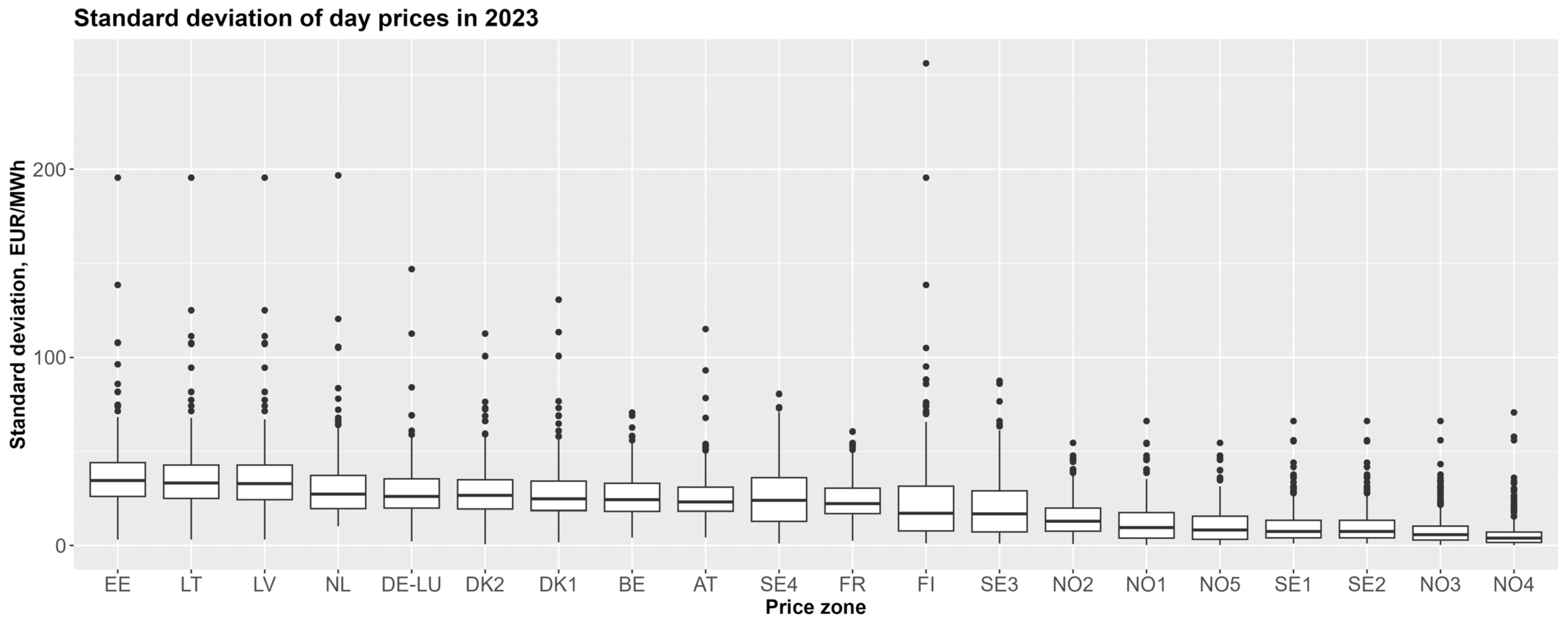
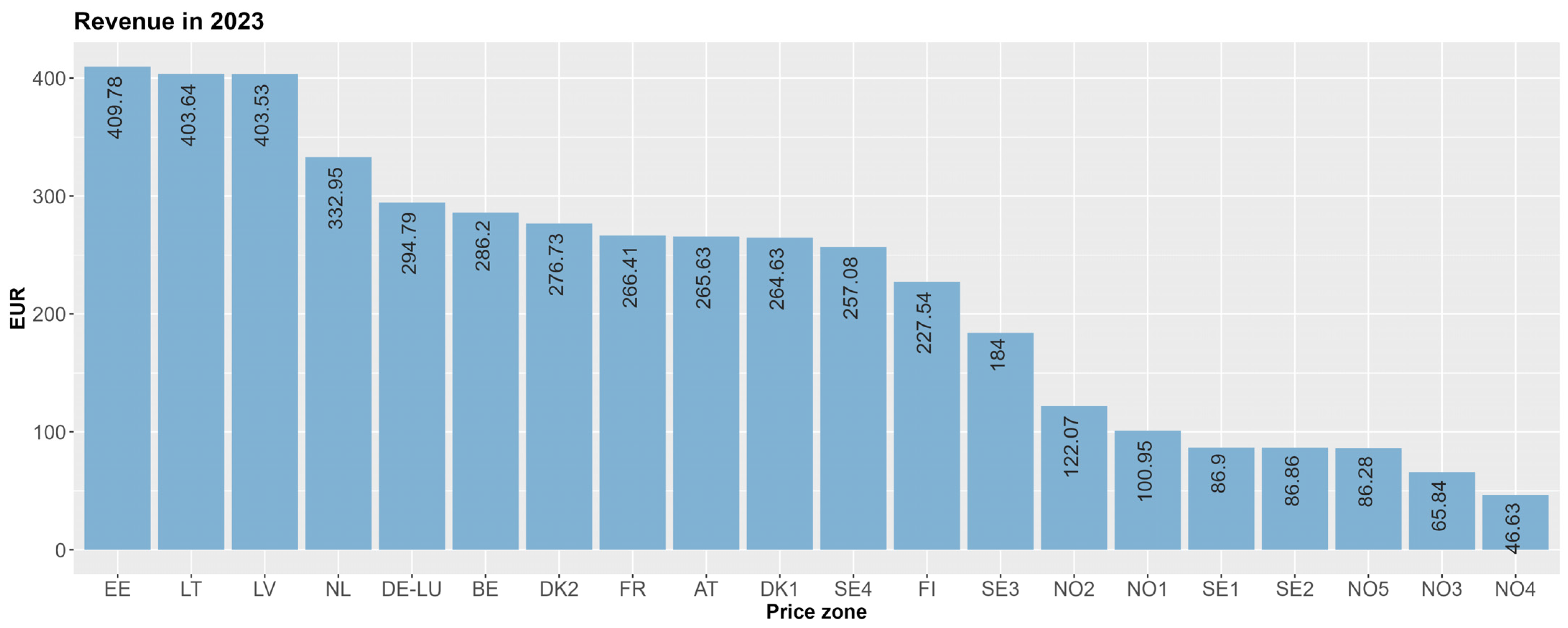
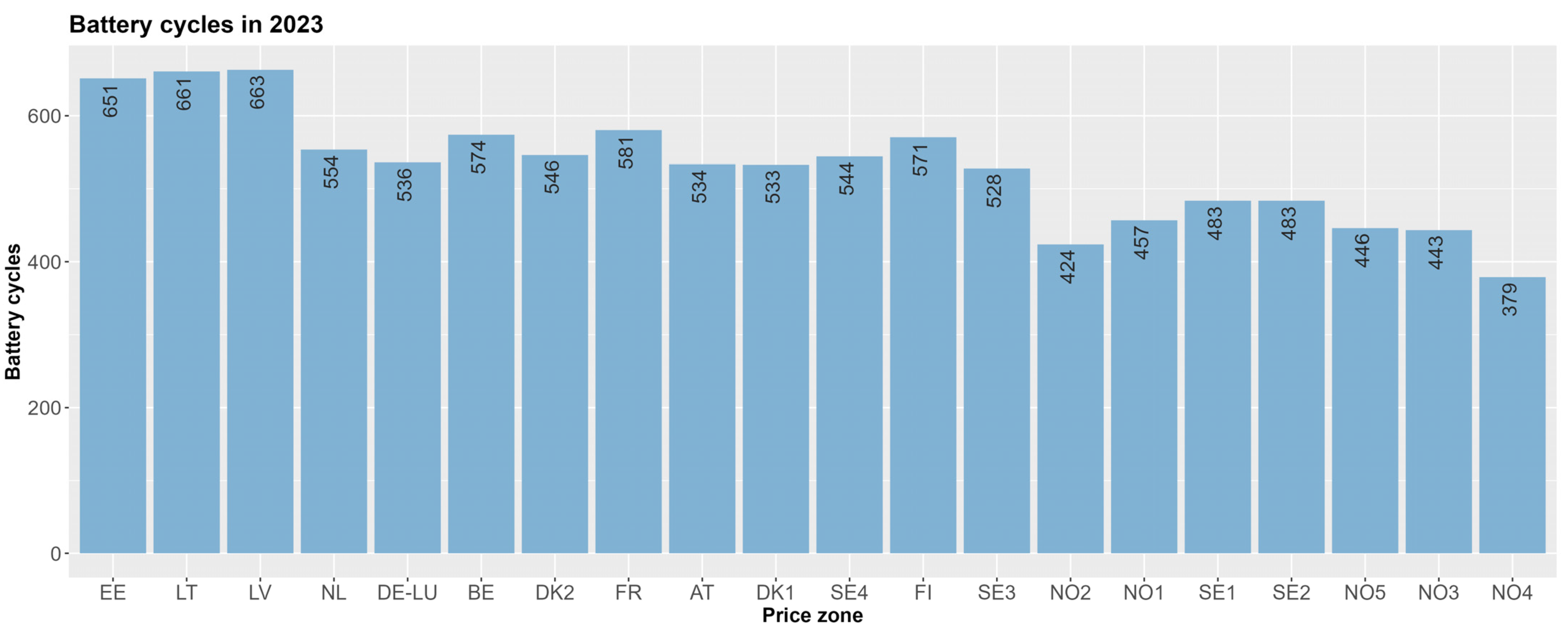
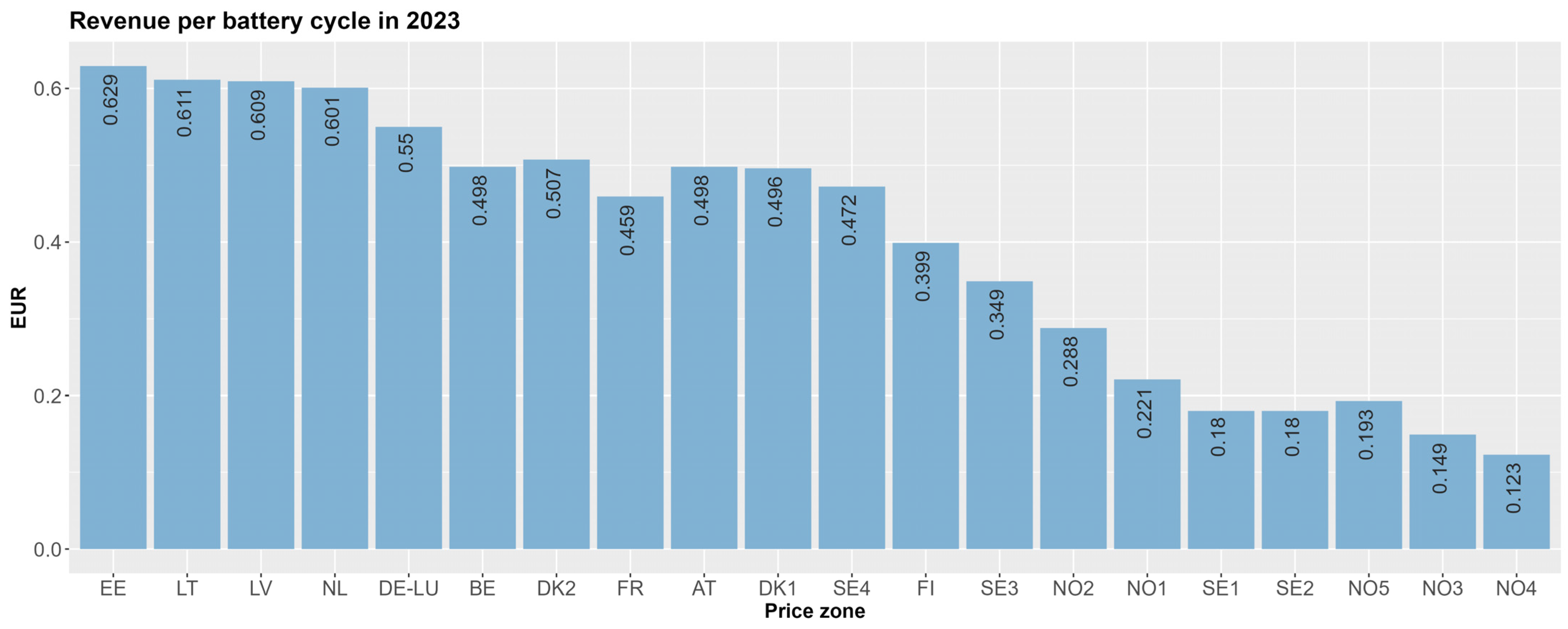
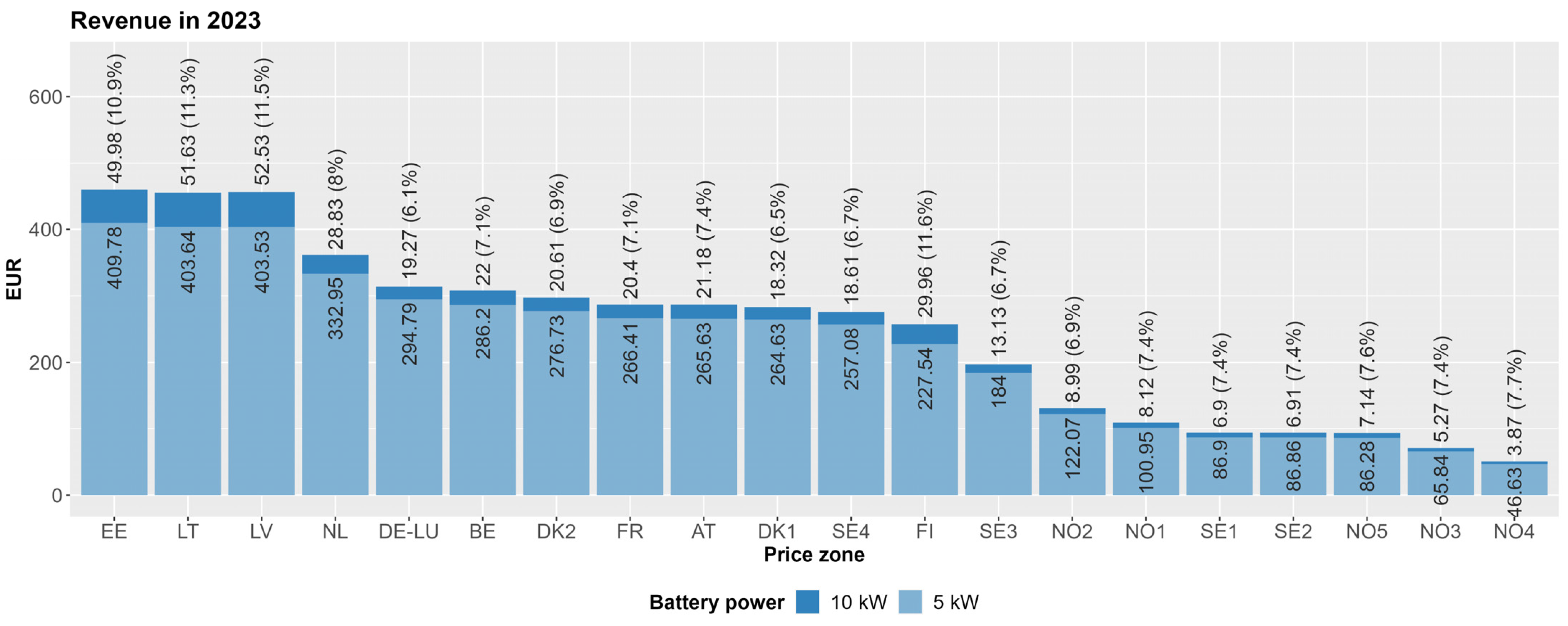


| Zone | Country | EUR/MWh | ||||
|---|---|---|---|---|---|---|
| Mean | Max | Min | SD | Sum, Thousand | ||
| AT | Austria | 102.14 | 437.47 | −500.00 | 44.38 | 894.76 |
| BE | Belgium | 97.27 | 330.36 | −120.00 | 45.87 | 852.08 |
| DK1 | Denmark | 86.83 | 524.27 | −440.10 | 48.82 | 760.60 |
| DK2 | 81.25 | 524.27 | −60.04 | 50.12 | 711.78 | |
| EE | Estonia | 90.79 | 777.18 | −60.04 | 55.79 | 795.31 |
| FI | Finland | 56.47 | 777.18 | −500.00 | 56.71 | 494.65 |
| FR | France | 96.86 | 276.12 | −134.94 | 45.53 | 848.46 |
| DE-LU | Germany–Luxembourg | 95.18 | 524.27 | −500.00 | 47.58 | 833.74 |
| LV | Latvia | 93.89 | 777.18 | −56.55 | 54.55 | 822.51 |
| LT | Lithuania | 94.44 | 777.18 | −56.55 | 54.87 | 827.31 |
| NL | Netherlands | 95.82 | 463.77 | −500.00 | 49.05 | 839.36 |
| NO1 | Norway | 66.95 | 332.00 | −61.84 | 44.68 | 586.49 |
| NO2 | 79.45 | 261.85 | −61.84 | 36.29 | 695.95 | |
| NO3 | 38.55 | 332.00 | −10.06 | 32.79 | 337.74 | |
| NO4 | 29.95 | 332.00 | −10.06 | 26.21 | 262.34 | |
| NO5 | 67.05 | 261.85 | −6.62 | 43.40 | 587.32 | |
| SE1 | Sweden | 39.97 | 332.00 | −60.04 | 34.17 | 350.15 |
| SE2 | 39.98 | 332.00 | −60.04 | 34.16 | 350.20 | |
| SE3 | 51.70 | 332.00 | −60.04 | 45.33 | 452.90 | |
| SE4 | 64.88 | 332.00 | −60.04 | 50.64 | 568.34 | |
Disclaimer/Publisher’s Note: The statements, opinions and data contained in all publications are solely those of the individual author(s) and contributor(s) and not of MDPI and/or the editor(s). MDPI and/or the editor(s) disclaim responsibility for any injury to people or property resulting from any ideas, methods, instructions or products referred to in the content. |
© 2024 by the authors. Licensee MDPI, Basel, Switzerland. This article is an open access article distributed under the terms and conditions of the Creative Commons Attribution (CC BY) license (https://creativecommons.org/licenses/by/4.0/).
Share and Cite
Paulauskas, N.; Kapustin, V. Battery Scheduling Optimization and Potential Revenue for Residential Storage Price Arbitrage. Batteries 2024, 10, 251. https://doi.org/10.3390/batteries10070251
Paulauskas N, Kapustin V. Battery Scheduling Optimization and Potential Revenue for Residential Storage Price Arbitrage. Batteries. 2024; 10(7):251. https://doi.org/10.3390/batteries10070251
Chicago/Turabian StylePaulauskas, Nerijus, and Vsevolod Kapustin. 2024. "Battery Scheduling Optimization and Potential Revenue for Residential Storage Price Arbitrage" Batteries 10, no. 7: 251. https://doi.org/10.3390/batteries10070251





